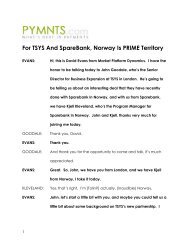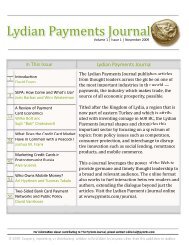Interchange Fees: The Economics and Regulations of What
Interchange Fees: The Economics and Regulations of What
Interchange Fees: The Economics and Regulations of What
- No tags were found...
You also want an ePaper? Increase the reach of your titles
YUMPU automatically turns print PDFs into web optimized ePapers that Google loves.
2 INTERCHANGE FEESI. INTRODUCTIONIn 1958, Bank <strong>of</strong> America began operating the BankAmericard credit card system, the predecessor<strong>of</strong> Visa, as a unitary system. 1 It performed both the issuing function (dealing with cardholders)<strong>and</strong> the acquiring function (dealing with merchants) itself. Similarly, it set the fees charged toboth these customer classes—the annual fee, interest rate, late fees, <strong>and</strong> other fees charged to cardholders<strong>and</strong> the per-transaction fee to merchants known as the merchant discount. It was thereforeable to determine both the overall level <strong>of</strong> fees (which might be measured as total fees per dollar<strong>of</strong> transactions) <strong>and</strong> their structure (which might be measured by the shares <strong>of</strong> total fees paid bymerchants <strong>and</strong> cardholders).In 1966, the Bank <strong>of</strong> America began to bring other banks into the system as franchisees.Individual banks within the system were free then, as now, to determine the fees they chargedmerchants <strong>and</strong> cardholders. When a consumer holding a card issued by bank A made a purchase ata merchant that had bank A as its acquirer, bank A could, if it wished, have the same fee structureas Bank <strong>of</strong> America. But what if this same consumer made a purchase from a merchant acquiredby bank B? Bank <strong>of</strong> America required the acquiring bank to pass the full merchant discount to theissuing bank. Acquiring banks had incentives to lie about their merchant discounts under this rule,as issuing banks were well aware. More importantly, this rule meant that acquiring banks receivedzero revenue for transactions for which they provided the merchant but had not issued the cardbeing used. <strong>The</strong> rule therefore blunted the incentives for all banks to sign up merchants, to theobvious determent <strong>of</strong> the system as a whole.In 1970 the BankAmericard system was converted into a membership corporation, a multipartysystem. This cooperative association established an interchange fee in 1971 to deal with transactionsin which issuing <strong>and</strong> acquiring banks were different. This fee was paid by the acquiringbank to the issuing bank <strong>and</strong> initially set at 1.95 percent. It was not linked to any individual bank’smerchant discount. <strong>The</strong> interchange fee thus became a revenue source on the issuing side <strong>of</strong> thecredit card business <strong>and</strong> a cost element on the acquiring side. Acquiring banks had to charge amerchant discount that was greater than the interchange fee to recover this cost. <strong>The</strong> interchangefee was an element <strong>of</strong> a st<strong>and</strong>ard contract that the multi-party system established for its members;other terms <strong>of</strong> the contract defined who bore the risk <strong>of</strong> fraud or nonpayment, as well as how disputeswould be resolved.This essay surveys the economic literature on interchange fees <strong>and</strong> the debate over whetherinterchange should be regulated <strong>and</strong>, if so, how.1This discussion in this paragraph <strong>and</strong> the next two follows Evans <strong>and</strong> Schmalensee (2005, pp. 153-156).








